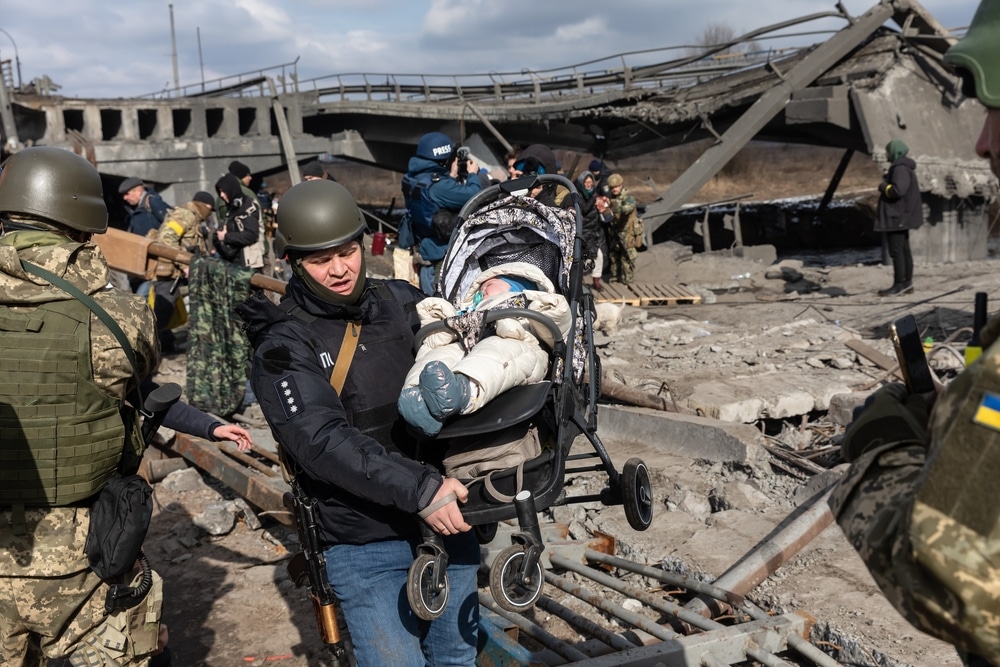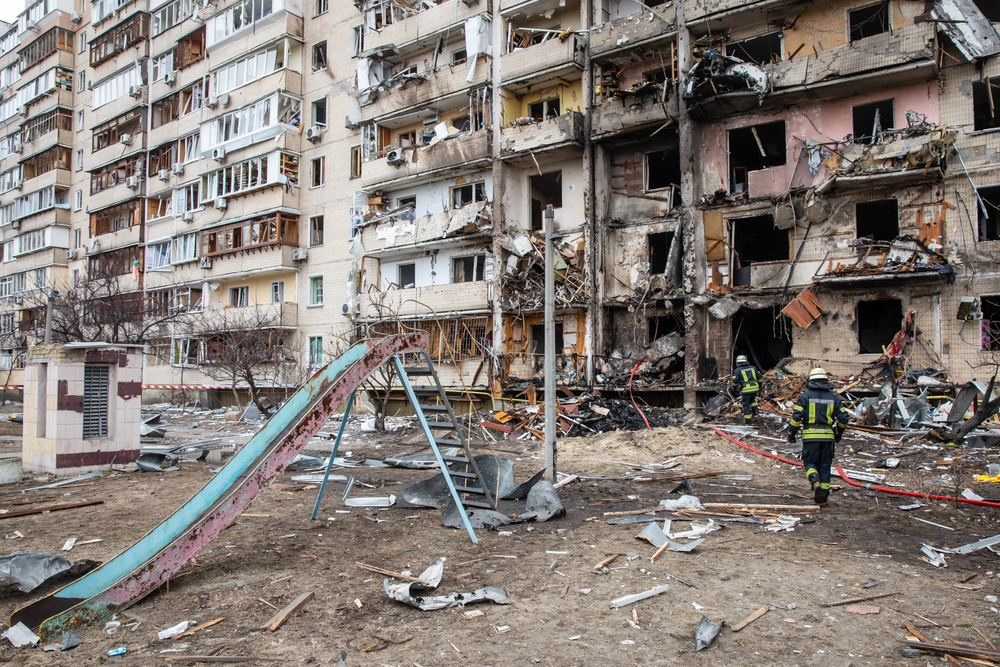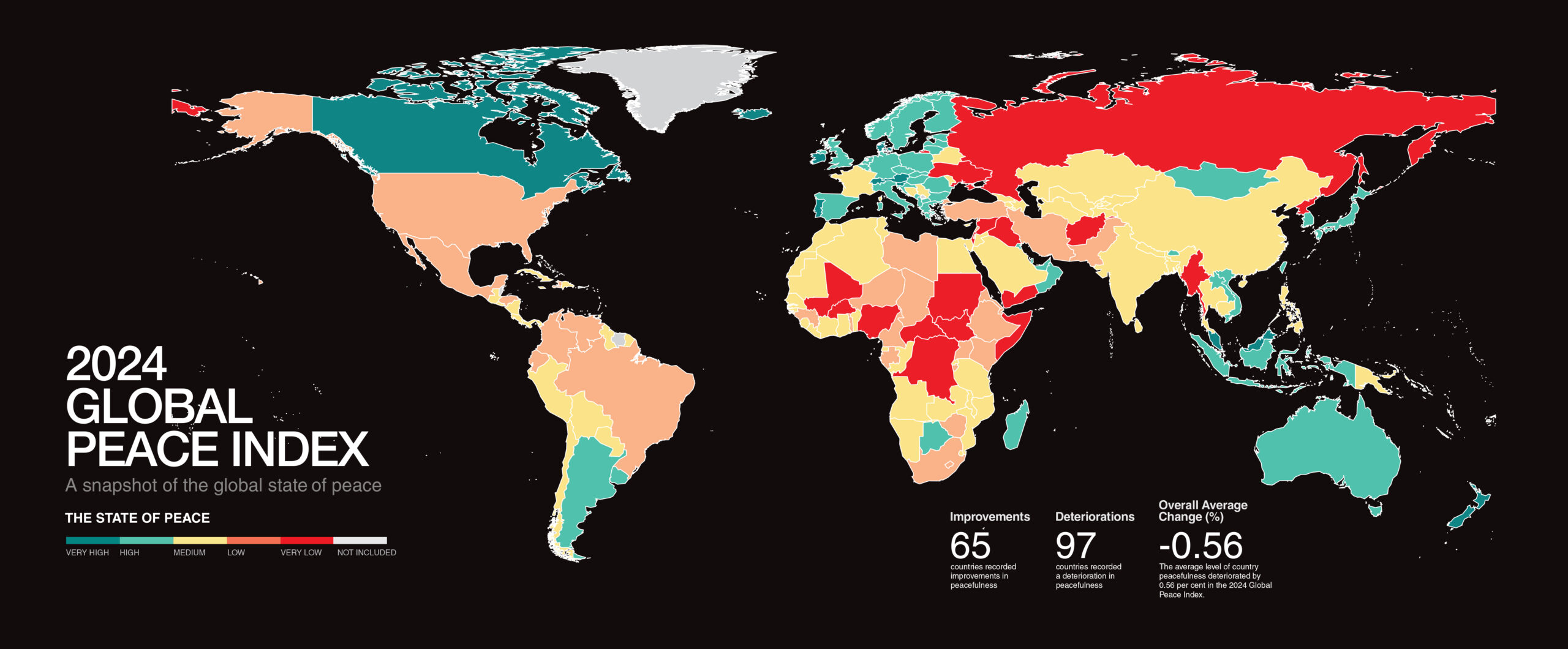Aside from the human cost of conflict, violence and the fear of violence create significant economic disruptions. In 2023, the impact of violence on the global economy was equivalent to 13.5 per cent of global GDP as the total economic impact of violence increased by 0.83 per cent over the past year.
Understanding the Economic Value of Peace
The global economic impact of violence is defined as the money spent and the economic effect of containing, preventing and dealing with the consequences of violence.
The economic impact of violence provides a basis to better understand the economic benefits of improvements in peace. Violence and the fear of violence create significant economic disruptions. For instance, violent incidents generate costs in the form of property damage, physical injury, or psychological trauma. Additionally, fear of violence also alters the way money is spent, primarily by reducing tendencies to invest and consume.
The total economic impact of violence has three components that represent different ways in which violence impacts economic activity: direct costs, indirect costs, and a multiplier effect.
The direct costs of violence include the immediate consequences to the victims, perpetrators, and public systems, including health, judicial, and public safety. The indirect cost refers to longer-term costs, such as lost productivity resulting from the physical and psychological effects of violence and the impact of violence on the perception of safety and security in society. The multiplier effect represents the economic benefits that would be generated by investment in more productive alternatives than dealing with violence.

The Composition of the Economic Value of Peace in 2023
The single largest component was global military expenditure, which totalled $8.4 trillion, or 44 per cent of the total economic impact. Globally, the economic impact of military expenditure increased by 1.4 per cent in 2023, equivalent to $116.3 billion. There has been a large increase in military expenditure over the past few years, with many European countries committing to spending more in future years, due in large part to the ongoing conflict in Ukraine.
Internal security expenditure was the second largest component, comprising 30 per cent of the global economic impact of violence, at $5.4 trillion. It includes spending on the police and judicial system and the costs of incarceration.
Expenditure on private security decreased by 0.2 per cent to $1.3 trillion. Private security is the third largest category in the model and comprises 6.9 per cent of the total.
Homicide is the fourth largest component in the model, comprising seven per cent of the global economic impact of violence, at $1.1 trillion.
Trends in the Economic Impact of Violence
The Global Peace Index 2024 finds that the overall impact of violence is 7.4 per cent higher in 2023 than 2008. Substantial improvements were recorded between 2010 and 2012, after which the impact has steadily risen. Since 2008, 89 countries recorded a deterioration in their economic impact of violence, while 74 had improvements.
The economic impact of violence has increased year on year for 10 of the past 15 years. Between 2008 and 2024, there was a 9 per cent increase in the total economic impact of violence. Costs associated with conflict deaths and GDP losses from conflict rose most significantly, with both more than doubling.
Long-term trends in the economic impact of violence differ among the three domains of violence. The total economic impact of violence increased across all three domains. The Armed Conflict domain has substantially deteriorated since 2013, while Violence Containment and Interpersonal and Self-Inflicted Violence only had small relative increases. The economic impact of armed conflict has almost tripled since 2008.

Regional Trends in the Economic Impact of Violence
There are noticeable regional differences in the economic impact of violence. The economic impact of violence deteriorated for most regions of the world in 2023.
South Asia had the largest deterioration, while Russia and Eurasia saw the largest improvement. The deterioration in South Asia can be attributed to a rise in GDP losses and costs associated with conflict deaths in Pakistan. The improvement in Russia and Eurasia came from a $2.1 billion reduction in the impact of GDP losses from Ukraine. This is because the first year of the conflict with Russia had the greatest impact on Ukrainian GDP.
Central America and the Caribbean is the second region that experienced an improvement in the economic impact of violence. This is largely driven by a dramatic $1 billion decrease in the economic impact of homicide in El Salvador.
The greatest variation between regions is in military expenditure. This represents 55.8 per cent of the economic impact for the MENA region, and 12.7 per cent in the Central America and the Caribbean region.

10 Countries with the Highest Economic Cost of Violence as a percentage of GDP in 2023
There are six countries where the cost of violence is equivalent to more than 30 per cent of GDP.
Ukraine (Economic Cost of Violence as 68.52% of GDP) – The conflict between Russia and Ukraine has resulted in over 2,000 battle deaths a month for almost every month since February 2022. The conflict is now entering its third year with neither side making significant gains.
Afghanistan (Economic Cost of Violence as 53.19% of GDP) – The withdrawal of US troops in mid 2021 and the rise to power of the Taliban has complicated the geopolitical landscape in Afghanistan. The 2024 GPI finds that the situation persists with minimal prospects for resolution and potential for significant escalation. The humanitarian crisis in Afghanistan is worsening, with more than 28 million people in need of humanitarian aid, and over 20 million people reaching crisis levels of food insecurity. There have also been reports of women’s rights violations, extrajudicial killings and attacks on civilians.
North Korea (Economic Cost of Violence as 41.57% of GDP) – The two Koreas have been divided since the Korean War ended in 1953. In 2024, North Korean leader Kim Jong Un announced North Korea’s refusal to seek reunification with South Korea, and the launching of three new military spy satellites. Between 2023 and 2024, numerous missile tests were also carried out. The 2024 GPI finds that North Korea has the highest per capita expenditure on its military.
Somalia (Economic Cost of Violence as 39.78% of GDP) – The civil war in Somalia has been ongoing for over 20 years. The Islamist militant Al Shabaab controls vast areas of the south and centre of Somalia and have been fighting the government since 2006 to establish their own rule, based on their interpretation of Islamic law. In 2023, the Somalian government sought to increase its efforts to increase security through military efforts against Al Shabaab, while also managing a humanitarian crisis with 6.7 million people facing acute food insecurity and one million people displaced.
Colombia (Economic Cost of Violence as 33.77% of GDP) – In Colombia, an increase in attacks by splinter militias, mainly ex-FARC members, have led to 781 internal conflict deaths. In addition, Colombia was the only country to record a terrorism death in 2023 in South America. The new government has also struggled to fully implement the peace agreement that was reached in 2016, with clashes between the government and dissident rebel groups occurring.
Central African Republic (Economic Cost of Violence as 33.76% of GDP) – The CAR has been almost continuously unstable since independence from France in 1960. In 2013 Muslim rebels from the Seleka umbrella group seized power. Seleka handed power to a transitional government in 2014 under international pressure, but the country remains in turmoil, with the government controlling only part of the country, challenged by rebel groups. A humanitarian crisis is also occurring, with over one million people displaced, and 3.4 million people in need of assistance.
Sudan (Economic Cost of Violence as 29.90% of GDP) – Civil war erupted in April 2023, with the Sudanese Armed Forces (SAF) and the Rapid Support Forces (RSF) dividing the country, fighting for control, and each supported by other ethno-political militias and factions. The conflict has resulted in the world’s worst refugee crisis with over 10 million people displaced, credible reports of atrocities by both SAF and RSF, and estimates of catastrophically large death tolls.
Cyprus (Economic Cost of Violence as 28.61% of GDP) – The island was split in a Turkish invasion in 1974 after a brief Greek-inspired coup, and reunification efforts have failed. The United Nations administers a buffer zone which separates Cyprus east to west between opposing Turkish and Greek Cypriot sides. In 2024, the United Nations has persisted with attempts to foster negotiation in peace talks.
Burkina Faso (Economic Cost of Violence as 23.47% of GDP) – The country has faced jihadist attacks since 2015, but fatalities and humanitarian needs have hit record highs since a second military junta seized power in 2022, and then escalated conflict with the insurgents, who control around 40 per cent of the country. Almost 7,600 deaths were recorded in this conflict in 2023. Most recent estimates in 2024 suggest that 6.3 million people are in need of humanitarian assistance, more than 2.7 million people have reached crisis levels of food insecurity.
Palestine (Economic Cost of Violence as 21.27% of GDP) – The conflict between Israel and Palestine escalated dramatically in 2023 after the October 7th terrorist attacks and subsequent military invasion of Gaza. However, tensions had been rising since 2020. It is estimated that over 17,000 Palestinians were killed in the Gaza conflict in 2023, with the latest data indicating that this number had increased to over 33,000 as of April 2024 with some estimates placing the number much higher at over 100,000.
— Download the Global Peace Index 2024 press release here.
— Request a media interview here.
— View the Global Peace Index 2024 interactive map here.